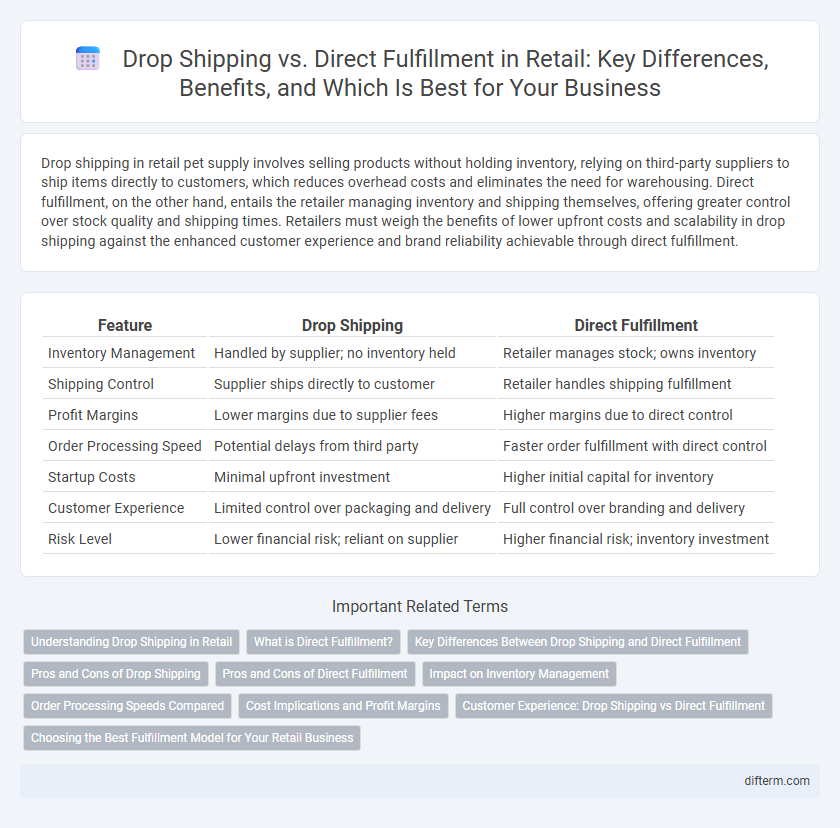Drop shipping in retail pet supply involves selling products without holding inventory, relying on third-party suppliers to ship items directly to customers, which reduces overhead costs and eliminates the need for warehousing. Direct fulfillment, on the other hand, entails the retailer managing inventory and shipping themselves, offering greater control over stock quality and shipping times. Retailers must weigh the benefits of lower upfront costs and scalability in drop shipping against the enhanced customer experience and brand reliability achievable through direct fulfillment.
Table of Comparison
| Feature | Drop Shipping | Direct Fulfillment |
|---|---|---|
| Inventory Management | Handled by supplier; no inventory held | Retailer manages stock; owns inventory |
| Shipping Control | Supplier ships directly to customer | Retailer handles shipping fulfillment |
| Profit Margins | Lower margins due to supplier fees | Higher margins due to direct control |
| Order Processing Speed | Potential delays from third party | Faster order fulfillment with direct control |
| Startup Costs | Minimal upfront investment | Higher initial capital for inventory |
| Customer Experience | Limited control over packaging and delivery | Full control over branding and delivery |
| Risk Level | Lower financial risk; reliant on supplier | Higher financial risk; inventory investment |
Understanding Drop Shipping in Retail
Drop shipping in retail allows merchants to sell products without holding inventory by partnering with suppliers who ship orders directly to customers, reducing upfront costs and inventory risks. This model enhances scalability and product range, enabling retailers to test new markets quickly without warehousing expenses. Efficient supplier reliability and accurate product information are crucial for maintaining customer satisfaction and minimizing fulfillment delays in drop shipping operations.
What is Direct Fulfillment?
Direct Fulfillment is a retail supply chain method where products are shipped directly from the manufacturer or wholesaler to the customer, bypassing the retailer's physical inventory. This approach allows retailers to offer a wider product selection without investing in storage or handling, reducing overhead costs and risks associated with inventory management. Retailers maintain control over branding and customer service while leveraging supplier logistics for faster delivery times and improved order accuracy.
Key Differences Between Drop Shipping and Direct Fulfillment
Drop shipping allows retailers to sell products without holding inventory, as suppliers ship items directly to customers, minimizing upfront costs and inventory risks. Direct fulfillment requires retailers to purchase products in advance, store them, and manage shipping, which offers greater control over packaging and shipping speed. Key differences include inventory management responsibilities, control over customer experience, and cash flow implications, significantly influencing operational efficiency and scalability in retail businesses.
Pros and Cons of Drop Shipping
Drop shipping allows retailers to sell products without maintaining inventory, reducing upfront costs and minimizing financial risks. However, it often leads to lower profit margins, less control over inventory and shipping processes, and potential delays in order fulfillment. Managing supplier reliability and customer service quality remains a critical challenge for businesses relying on drop shipping models.
Pros and Cons of Direct Fulfillment
Direct fulfillment offers retailers real-time inventory control and faster shipping times by managing products directly from the warehouse, enhancing customer satisfaction. It reduces dependency on third-party suppliers, lowering the risk of stockouts and improving product quality consistency. However, direct fulfillment requires significant investment in warehousing infrastructure and logistics management, which can increase operational costs and complexity.
Impact on Inventory Management
Drop shipping eliminates the need to hold physical inventory, allowing retailers to reduce storage costs and minimize stockouts by relying on suppliers to fulfill orders directly. Direct fulfillment requires maintaining accurate inventory records and synchronization between warehouses and sales channels to prevent overselling and ensure timely delivery. Effective inventory management in direct fulfillment enhances stock visibility and demand forecasting, improving overall supply chain efficiency.
Order Processing Speeds Compared
Drop shipping offers slower order processing speeds due to reliance on third-party suppliers to ship products directly to customers, often causing delays and less control over inventory management. Direct fulfillment enables retailers to process orders faster by handling inventory in-house or through integrated warehouses, speeding up picking, packing, and shipping. Retailers seeking faster delivery times and improved customer satisfaction typically prefer direct fulfillment for optimized order processing efficiency.
Cost Implications and Profit Margins
Drop shipping reduces upfront inventory costs by eliminating the need for warehousing, but often comes with lower profit margins due to higher supplier fees and shipping costs. Direct fulfillment requires investment in inventory and storage, increasing operational expenses but allowing greater control over product pricing and potentially higher profit margins. Retailers must balance initial cost savings against long-term profitability when choosing between drop shipping and direct fulfillment models.
Customer Experience: Drop Shipping vs Direct Fulfillment
Drop shipping offers customers a wider product range and faster inventory updates but may result in inconsistent packaging and longer delivery times due to reliance on third-party suppliers. Direct fulfillment provides better control over shipping quality, faster delivery, and improved return handling, enhancing overall customer satisfaction. Retailers prioritizing seamless customer experience often prefer direct fulfillment to ensure consistent brand presentation and reliable service.
Choosing the Best Fulfillment Model for Your Retail Business
Evaluating drop shipping versus direct fulfillment hinges on factors like inventory control, shipping speed, and customer experience. Drop shipping minimizes upfront inventory costs by shipping directly from suppliers, but may sacrifice delivery speed and quality oversight. Direct fulfillment demands more inventory investment but offers faster shipping, better brand control, and enhanced customer satisfaction for retail businesses seeking reliability and scalability.
Drop Shipping vs Direct Fulfillment Infographic

 difterm.com
difterm.com